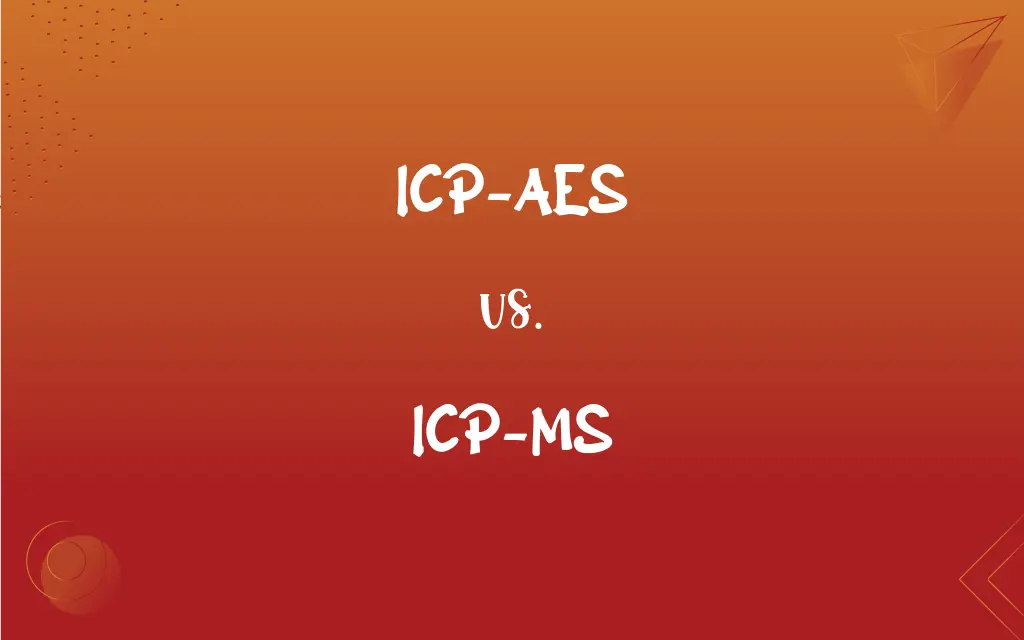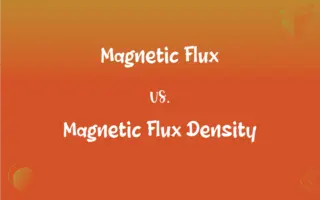ICP-AES vs. ICP-MS: What's the Difference?
Edited by Aimie Carlson || By Janet White || Published on March 5, 2024
ICP-AES (Inductively Coupled Plasma Atomic Emission Spectroscopy) uses plasma to excite atoms for emission spectral analysis, while ICP-MS (Inductively Coupled Plasma Mass Spectrometry) uses plasma to ionize sample atoms for mass spectrometry analysis.

Key Differences
ICP-AES, or Inductively Coupled Plasma Atomic Emission Spectroscopy, is an analytical technique used to detect and quantify elements in a sample by measuring the intensity of light emitted at specific wavelengths. In ICP-AES, a sample is introduced into a plasma, which is a highly ionized gas that excites the atoms in the sample. On the other hand, ICP-MS, or Inductively Coupled Plasma Mass Spectrometry, is an analytical technique that uses mass spectrometry to detect and quantify elements in a sample. In ICP-MS, the sample is also introduced into a plasma, but instead of measuring emitted light, the technique measures the mass-to-charge ratio of ions.
One of the main differences between ICP-AES and ICP-MS is their detection limits. ICP-MS generally has lower detection limits than ICP-AES, allowing for the analysis of elements at lower concentrations. Additionally, ICP-MS can provide isotopic information, which is useful for isotope ratio studies and tracing the origin of elements.
Another difference is the range of elements that can be analyzed. While both techniques can analyze a wide range of elements, ICP-MS is more suitable for elements that are difficult to ionize or have low emission intensities in ICP-AES. However, ICP-AES is often preferred for routine analysis of major elements due to its simpler operation and lower cost.
ICP-AES and ICP-MS are both powerful techniques for elemental analysis, but they differ in their detection limits, range of analyzable elements, and the type of information they provide. The choice between ICP-AES and ICP-MS depends on the specific requirements of the analysis, such as sensitivity, cost, and the need for isotopic information.
Comparison Chart
Detection Principle
Measures light emission at specific wavelengths
Measures mass-to-charge ratio of ions
ADVERTISEMENT
Sensitivity
Good sensitivity, suitable for major elements
Higher sensitivity, suitable for trace elements
Isotopic Information
No isotopic information
Provides isotopic information
Range of Elements
Wide range, but limited for some elements
Broader range, including elements with low ionization energy
Cost and Complexity
Generally lower cost and simpler operation
Higher cost and more complex operation
ICP-AES and ICP-MS Definitions
ICP-AES
ICP-AES is often used in environmental, agricultural, and geological studies.
ICP-AES was utilized to monitor trace metal pollution in river water.
ADVERTISEMENT
ICP-MS
ICP-MS has a broad range of applications, including forensic analysis and pharmaceutical testing.
The forensic team employed ICP-MS to analyze trace elements in hair samples.
ICP-AES
It measures the intensity of light emitted by excited atoms in a sample.
The ICP-AES instrument calibrated the emission lines of metals in the soil sample.
ICP-MS
It offers high sensitivity and can measure trace elements at very low concentrations.
The lab used ICP-MS to analyze the presence of rare earth elements in ores.
ICP-AES
The technique offers good sensitivity and precision for major elements.
ICP-AES provided accurate measurements of calcium and magnesium in plant tissues.
ICP-MS
ICP-MS can provide isotopic information, useful for geochemical and environmental studies.
Isotopic ratios of lead were determined using ICP-MS to trace pollution sources.
ICP-AES
ICP-AES is an analytical technique for elemental analysis using plasma-induced emission spectra.
ICP-AES is commonly used in environmental labs for water quality testing.
ICP-MS
The technique is widely used in environmental, biomedical, and material science research.
ICP-MS played a crucial role in assessing nanoparticle toxicity in cells.
ICP-AES
ICP-AES is suitable for simultaneous analysis of multiple elements.
The research team employed ICP-AES to analyze the mineral content in rock samples.
ICP-MS
ICP-MS is an analytical technique that combines plasma ionization with mass spectrometry.
ICP-MS was used to detect trace levels of heavy metals in blood samples.
FAQs
What is ICP-AES?
ICP-AES (Inductively Coupled Plasma Atomic Emission Spectroscopy) is a technique for analyzing the elemental composition of a sample by measuring the light emitted from excited atoms in a plasma.
What are the advantages of ICP-AES?
ICP-AES offers good sensitivity, simultaneous multi-element analysis, and is suitable for a wide range of elements, especially major elements.
What is ICP-MS?
ICP-MS (Inductively Coupled Plasma Mass Spectrometry) is an analytical technique that uses a plasma source to ionize sample atoms and a mass spectrometer to measure their mass-to-charge ratio.
What are the limitations of ICP-AES?
Limitations of ICP-AES include lower sensitivity for trace elements and interference from spectral overlaps.
How does ICP-AES work?
In ICP-AES, a sample is introduced into a plasma, where it is atomized and excited. The emitted light is measured at specific wavelengths corresponding to different elements.
How does ICP-MS work?
In ICP-MS, a sample is introduced into a plasma, where it is ionized. The ions are then separated by their mass-to-charge ratio using a mass spectrometer and detected.
What are common applications of ICP-AES?
ICP-AES is commonly used in environmental analysis, metallurgy, geochemistry, and quality control of materials.
What are common applications of ICP-MS?
ICP-MS is used in environmental monitoring, bioanalysis, isotopic studies, and trace element analysis in various fields.
What are the advantages of ICP-MS?
ICP-MS provides higher sensitivity, lower detection limits, isotopic information, and can analyze a broader range of elements, including trace elements.
Is ICP-AES suitable for trace element analysis?
ICP-AES is suitable for trace element analysis, but it may not be as sensitive as ICP-MS for very low concentrations.
Can ICP-AES provide isotopic information?
No, ICP-AES cannot provide isotopic information; it only measures the total concentration of elements.
Can ICP-AES and ICP-MS be used for qualitative analysis?
Both ICP-AES and ICP-MS are primarily used for quantitative analysis, but they can provide qualitative information about the presence of elements.
How do the costs of ICP-AES and ICP-MS compare?
ICP-MS is generally more expensive than ICP-AES due to its higher sensitivity and complexity.
Can ICP-AES and ICP-MS be used together in a single analysis?
While ICP-AES and ICP-MS are typically used separately, they can complement each other in a comprehensive analysis, with ICP-AES for major elements and ICP-MS for trace elements and isotopes.
What are the limitations of ICP-MS?
Limitations of ICP-MS include potential interferences from polyatomic ions and matrix effects, as well as higher cost and complexity.
What type of samples can be analyzed by ICP-MS?
ICP-MS can analyze liquids, solids (after digestion), and gases, with a focus on trace element analysis.
What type of samples can be analyzed by ICP-AES?
ICP-AES can analyze a variety of samples, including liquids, solids (after digestion), and gases.
Is ICP-MS suitable for major element analysis?
ICP-MS can be used for major element analysis, but it is often preferred for trace element analysis due to its higher sensitivity.
Can ICP-MS differentiate between isotopes of the same element?
Yes, ICP-MS can differentiate between isotopes of the same element, making it useful for isotope ratio analysis.
How do sample preparation methods differ for ICP-AES and ICP-MS?
Sample preparation methods for ICP-AES and ICP-MS are similar, involving digestion or dilution, but ICP-MS may require more careful preparation to avoid contamination.
About Author
Written by
Janet WhiteJanet White has been an esteemed writer and blogger for Difference Wiki. Holding a Master's degree in Science and Medical Journalism from the prestigious Boston University, she has consistently demonstrated her expertise and passion for her field. When she's not immersed in her work, Janet relishes her time exercising, delving into a good book, and cherishing moments with friends and family.
Edited by
Aimie CarlsonAimie Carlson, holding a master's degree in English literature, is a fervent English language enthusiast. She lends her writing talents to Difference Wiki, a prominent website that specializes in comparisons, offering readers insightful analyses that both captivate and inform.







































































